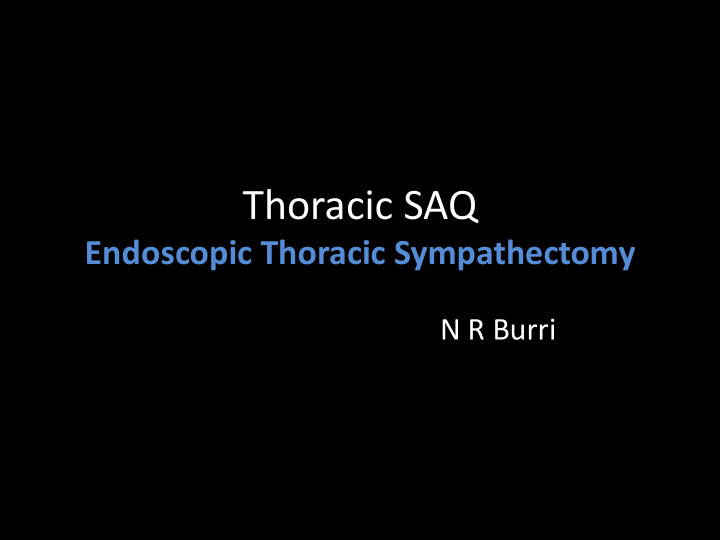



Thoracic SAQ Endoscopic Thoracic Sympathectomy N R Burri
Endoscopic Thoracic Sympathectomy Anaesthesia for endoscopic thoracic sympathectomy CEACCP| Volume 9 Number 2 2009
DIPLOMA OF FELLOW OF THE ROYAL COLLEGE OF ANAESTHETISTS FINAL EXAMINATION Tuesday 4th September 2012 9:30 am to 12:30 pm • a) List the indications for endoscopic thoracic sympathectomy (ETS). (25%) • b) Outline the general (30%) and airway (15%) implications of managing a patient for ETS under general anaesthesia. • c) What are the most likely problems to be encountered in the intraoperative (15%) • d) and postoperative period? (15%)
WEIGHTING • a) Indications……………………………..25%........5 • b) General implications GA…………30%........6 • Airway implications GA…………..15%........3 • c) Intraoperative problems…………15%.........3 • d ) Post operative problems…………15%........3
INDICATIONS…..5 marks • Mainly: Palmar Hyperhidrosis • Also for: Craniofacial hyperhidrosis Facial blushing Chronic Regional Pain Syndromes Ischaemic Upper Limb Syndrome Angina Pectoris Congenital long QT syndrome • No longer used for uncomplicated Reynaud’s
ANATOMY • T1 – L2 : Paravertebral sympathetic chains. • Short Pre & Long Post Ganglionic Fibres. • T1-2: H&N, T1-4: Thoracic Viscera, T2-5: UL • Run behind parietal pleura in upper chest. • Over the rib necks close to CostoVertebral Jn. • Rib seen upper most in Thoracoscopy: 2 nd
SYMPATHTEIC CHAIN SYMPATHETIC CHAIN COLLAPSED LUNG
GENERAL IMPLICATIONS - 6 marks Pre Op Assessment: • Generally fit & Young but assess CVS in angina Monitoring: • Standard monitoring / invasive if unstable CVS/ increase NIBP frequency. • Large bore IV access to cope with catastrophic bleeding Position: • Supine & Reverse Trendelenberg, Arms abducted • Prone & lateral positions described. • Pressure areas & nerve injuries • Port @ 4/5 ICS AAL: Avoids damage to Long Thoracic nerve of Bell Surgical Technique: • Extensive sympathectomy- compensatory sweating (50%) / limit the extent.
AIRWAY IMPLICATIONS - 3 marks TECHNIQUES: LA , SLT, DLT & Lung Isolation i. Original description under LA by Kux: Needle 5/6 ICS / Pneumothroax/ GA with SV /Prone position ( in 1978 !!!!) ii. GA with DLT for Lung Isolation/FOI check Isolation - gas insufflation is unnecessary / keep < 1 ltr of CO 2 insufflation. iii. GA with SLT without lung isolation: Necessary to insufflate CO 2 to visualize SC. Limit insufflation pressure to 5-10 mmHg. iv. Other options: Proseal LMA & IPPV / SLT+Blocker. NOTE: Use of DLT has replaced SLT use, worldwide.
INTRAOPAERAIVE PROBLEMS • Positioning: Brachial plexus Injuries (arm abduction) • OLV: Shunt up to 35% • Hypoxia: 2 0 Atelectasis & impaired HPV • Management: • Airway positioning / Gas/ FiO 2 / PEEP • CPAP isolated lung. intermittent coordinated ventilation. • Use air instead of N 2 0 • Minimal VA (Iso @1 MAC=20% impaired HPV) • TIVA: less impairment of HPV • Sudden cardiovascular collapse: 2 0 CO 2 insufflation. • Lung collapse on initial side: Reinflate under vision • Preparedness: To manage vascular trauma & emergency Thoracotomy
POST OPERATIVE PROBLEMS • Analgesia for Chest pain (Multimodal LA /Opiate/Paracetamol/NSAID) • Hypoxia: Residual Pneumothorax CXR • Compensatory sweating • Gustatory sweating • Horner’s syndrome • Subcutaneous emphysema • Haemothorax • Pleural effusion • Bleeding
Endoscopic transthoracic sympathectomy 26.5% pass rate . • Universally answered badly. • Never anaesthetized a patient for the procedure • No knowledge about the procedure despite being part of the syllabus. • Knowledge of OLA FOR A RELEVANT • Effects of a capnothorax ANSWER • Indications for a sympathectomy • Pass mark to reflect the level of difficulty (“hard”).
10 key facts out of 23 facts required to pass. Mean score 7.7/20 & SAQ WAS A STRONG DISCRIMINATOR a) Indications for transthoracic sympathectomy • Hyperhidrosis • Chronic pain/upper limb regional pain syndrome b) General Implications • Large bore IV access • Potential for major haemorrhage • May need arterial line Airway implications • May need double lumen tube c) Intraoperative problems • Hypotension from capnothorax , Hypoxia d) Postoperative problems • May have residual pneumothorax • May be painful
TH THANK NK YOU ALL & & WISH SH YOU U ALL TH THE BEST ST
Recommend
More recommend